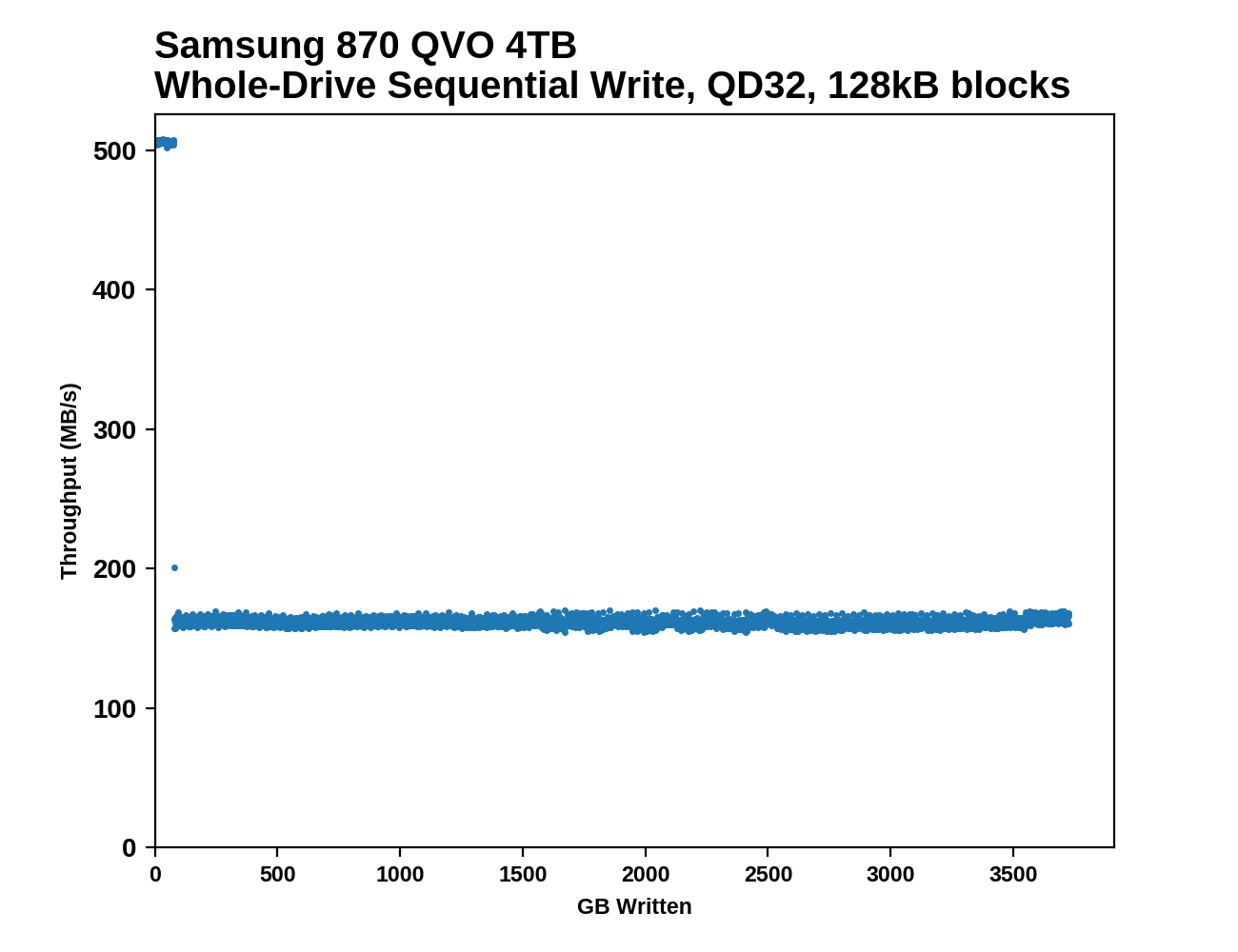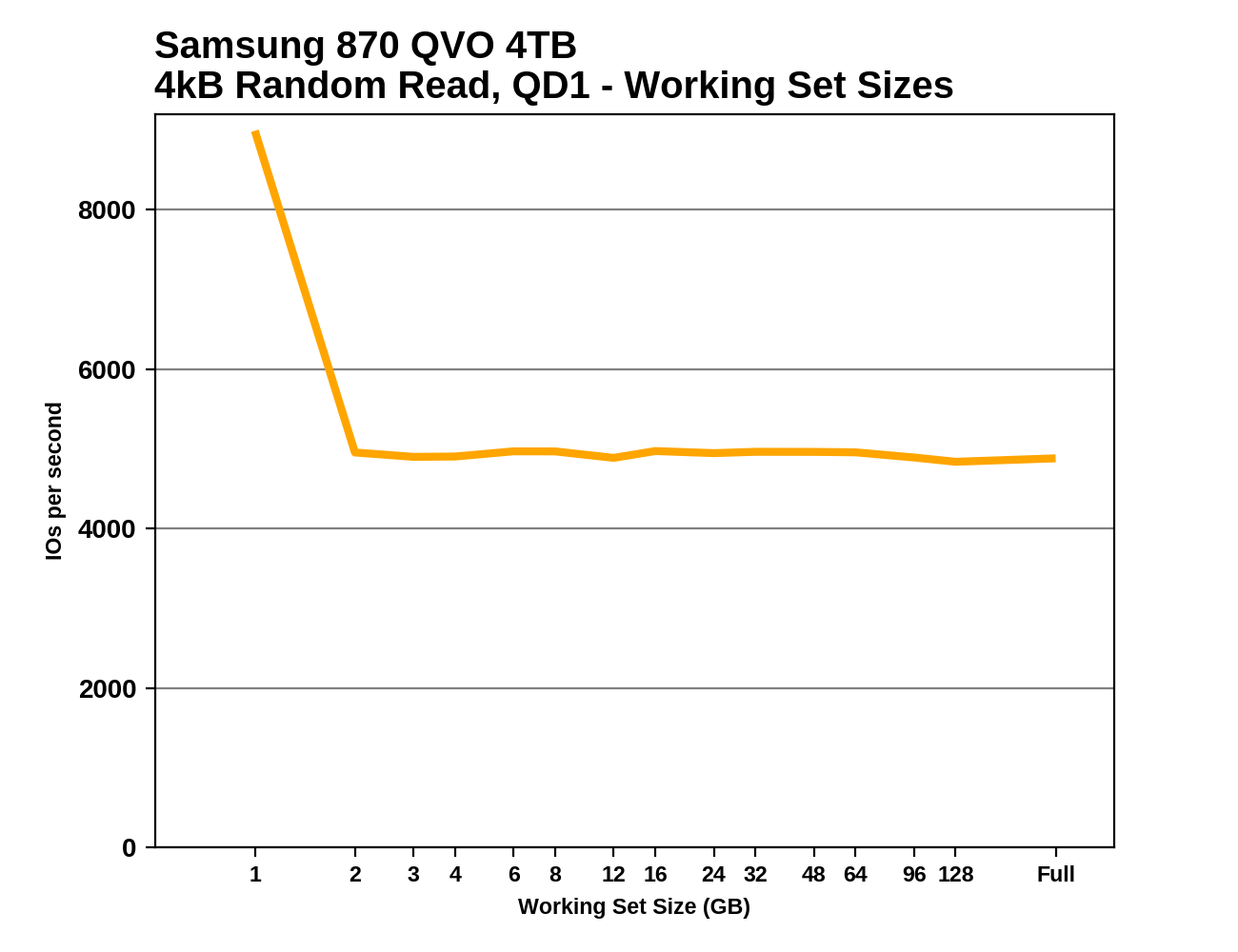The Samsung 870 QVO (1TB & 4TB) SSD Review: QLC Refreshed
by Billy Tallis on June 30, 2020 11:40 AM ESTWhole-Drive Fill
This test starts with a freshly-erased drive and fills it with 128kB sequential writes at queue depth 32, recording the write speed for each 1GB segment. This test is not representative of any ordinary client/consumer usage pattern, but it does allow us to observe transitions in the drive's behavior as it fills up. This can allow us to estimate the size of any SLC write cache, and get a sense for how much performance remains on the rare occasions where real-world usage keeps writing data after filling the cache.
 |
|||||||||
The SLC caches on the 870 QVOs run out right on schedule, at 42 GB and 78 GB. Write performance drops precipitously but is stable thereafter, for the rest of the drive fill process. This behavior hasn't changed meaningfully from the 860 QVO.
 |
|||||||||
| Average Throughput for last 16 GB | Overall Average Throughput | ||||||||
The 870 QVO turns in scores that are very similar to its predecessor. The 1TB model averages similar write performance to a hard drive, albeit with very different performance characteristics along the way. The 4TB model manages to stay ahead of the hard drive's write performance for pretty much the entire run. Both capacities of QLC drives offer a mere fraction of the post-cache write speed of mainstream TLC drives, and even the 2TB DRAMless TLC drive offers much better sequential write performance for almost all of the test duration.
Working Set Size
Most mainstream SSDs have enough DRAM to store the entire mapping table that translates logical block addresses into physical flash memory addresses. DRAMless drives only have small buffers to cache a portion of this mapping information. Some NVMe SSDs support the Host Memory Buffer feature and can borrow a piece of the host system's DRAM for this cache rather needing lots of on-controller memory.
When accessing a logical block whose mapping is not cached, the drive needs to read the mapping from the full table stored on the flash memory before it can read the user data stored at that logical block. This adds extra latency to read operations and in the worst case may double random read latency.
We can see the effects of the size of any mapping buffer by performing random reads from different sized portions of the drive. When performing random reads from a small slice of the drive, we expect the mappings to all fit in the cache, and when performing random reads from the entire drive, we expect mostly cache misses.
When performing this test on mainstream drives with a full-sized DRAM cache, we expect performance to be generally constant regardless of the working set size, or for performance to drop only slightly as the working set size increases.
 |
|||||||||
The 870 QVO clearly has improved read latency over its predecessors, and that's enough for the 1TB 870 to slightly outperform the ADATA SU750, a DRAMless TLC drive. The 4TB 870 QVO also shows a new behavior, with excellent random read performance at the very beginning of the test—better even that the TLC-based 860 EVOs. It looks like this test may have caught some data that was still being served from the SLC cache. Otherwise, the 870 QVOs don't care much about data locality for random reads, unlike many drives with limited or no DRAM cache.










64 Comments
View All Comments
FunBunny2 - Wednesday, July 1, 2020 - link
"QLC is garbage."alas, which manufacturers are going to ignore QLC? unless we, the consumers, stop buying QLC SSDs, vendors will continue to spit them out. and, yes, in due time, the SSD will perform much like HDD. progress and capitalism seldom coincide.
Great_Scott - Thursday, July 2, 2020 - link
QLC isn't garbage. There's a bunch of uses for this kind of drive.8TB of bulk storage for seldom-played games or music/movies? Sign me up!
The real problem here is that all SSDs cost roughly the same amount per GB, so there's no reason not to buy a better drive.
Maybe someday when there's a bigger pricing delta between "DRAM-less SATA" and "midrange PCIe" the numerous speed categories will make more (any) sense...
descendency - Friday, July 3, 2020 - link
The problem with QLC is that there aren't really substantial price savings from that of TLC or MLC that are passed onto the consumer. In the US (at least), the QVO drives are more expensive than some respectable TLC drives of the same capacity but without the performance limitations of QLC.I'm not going to call it garbage, but I would say these drives (the 8TB) models make more sense at ~650-750 USD given the compromises over EVO drives and other TLC drives. It's basically insane to see the 4TB QVO at $500 when some TLC drives are $480 (like Sandisk).
Gigaplex - Saturday, July 11, 2020 - link
"8TB of bulk storage for seldom-played games or music/movies? Sign me up!"You can do that now with an HDD. At a much cheaper price, and with somewhat equivalent performance.
Mitch89 - Thursday, July 2, 2020 - link
Wow, I’m disappointed at my ignorance as to how slow these QVO drives get once you exhaust the SLC cache, I had no idea they crashed to 2.5 inch HDD speeds.Sure, the “limited time only!!!!” speed of the SLC cache will be enough for many, but those speeds are still incredibly disappointing.
Great_Scott - Thursday, July 2, 2020 - link
They're still better than spinning rust, especially for burst performance. The real problem here is that they cost the same as other SSD technology.Dragonstongue - Friday, July 3, 2020 - link
I am sure Sammy can do much better pricing then this on QLC tech (just cause they fancy it up by calling QVO) does not mean an automatic $50+ price is in order.Worse overall flash memory style, therefore better pricing should be very much part of the thought process, but I suppose they must have thought, 80mb/s is plenty fast, so therefore, $400+ for 4tb is more then acceptable.
IMO make
4tb $325 max (consider horrendous perf. specs) the 1tb 120 flat, 2tb $215
does not matter what others are doing, or if their perf. power use etc is better or worse is how you price your product, @#$ on that logic lol
Lolimaster - Monday, July 6, 2020 - link
Thing is you can already get 2TB ssds for that price or less. MX500 2TB hovers around $189-219.Oxford Guy - Friday, July 3, 2020 - link
"QLC isn't garbage. There's a bunch of uses for this kind of drive."That's true.
It can be used as a Christmas tree ornament, if dissected.
The case can be used to provide a protective cover for a number of earwigs.
The innards can be strapped to a vinyl suit for a retro sci-fi show.
The mind boggles at the potential usefulness.
Slash3 - Sunday, July 5, 2020 - link
Great for sliding underneath a wobbly table leg, too.